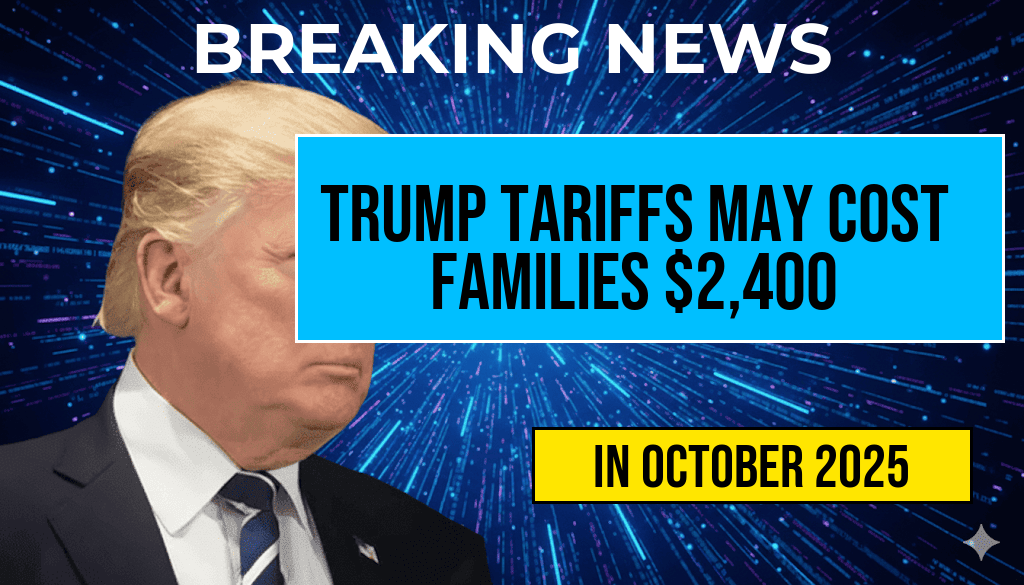Recent tariffs implemented under the Trump administration have sparked ongoing debates about their economic impact on American households. While tariffs are often framed as tools to protect domestic industries, their ripple effects can quietly inflate everyday costs for families. A new analysis suggests that the cumulative effect of these tariffs—sometimes called a “hidden turbulence tax”—could amount to as much as $2,400 annually per household. This figure isn’t just a reflection of higher prices at the checkout but also encompasses broader economic shifts, including increased supply chain costs and reduced market efficiency. As policymakers eye future trade strategies, understanding how these tariffs translate into real-world expenses is vital for consumers trying to navigate a landscape marked by rising prices and economic uncertainty.
The Mechanics Behind the ‘Turbulence Tax’
Tariffs are taxes imposed on imported goods, intended to shield domestic manufacturers from foreign competition. However, these taxes often lead to elevated costs that ripple through supply chains, affecting products from electronics to clothing. When tariffs are levied against key imports, companies face higher costs, which they may pass on to consumers in the form of increased retail prices. Over time, these incremental increases compound, creating what experts are now calling a “hidden turbulence tax.” This term encapsulates the unseen economic strain that tariffs impose on household budgets, often without consumers realizing the full extent of their contribution to rising expenses.
How Tariffs Impact Household Spending
- Increased Prices on Consumer Goods: Tariffs on imports such as electronics, furniture, and apparel result in higher retail prices, directly affecting family budgets.
- Supply Chain Disruptions: Higher import costs can lead to delays and shortages, further driving up prices and reducing product availability.
- Wider Economic Effects: Tariffs can slow economic growth, potentially leading to wage stagnation or job losses in affected industries, indirectly impacting household income.
Quantifying the Cost: How $2,400 Adds Up
Recent economic modeling indicates that the cumulative effect of tariffs could cost an average American family between $1,800 and $2,400 annually. This estimate considers increased prices across a broad basket of goods, from everyday essentials to discretionary items. For perspective, this amount is comparable to a monthly grocery bill for a family of four. The analysis draws on data from the economics of trade and recent consumer price index reports, highlighting how tariff-induced price increases subtly erode household budgets over time.
Breaking Down the Impact by Category
| Product Category | Average Additional Cost per Household |
|---|---|
| Electronics and gadgets | $600 |
| Clothing and footwear | $450 |
| Furniture and home goods | $300 |
| Food and beverages (imported) | $400 |
| Automotive parts and accessories | $350 |
These figures showcase how tariffs, although targeted at specific sectors, have broad-reaching consequences that translate into tangible costs for American families.
Economic Ripple Effects and Broader Implications
Beyond immediate price hikes, tariffs can influence employment and investment. When import costs rise, companies may reduce production or delay expansion plans, leading to slower economic growth. This environment can stifle wage growth and job security, indirectly diminishing household income. Additionally, retaliatory tariffs from trading partners may further restrict market access, compounding economic uncertainties and potentially reducing consumer spending power.
Policy Debates and Public Perception
Supporters of tariffs argue they protect critical industries and promote fair trade practices. However, critics emphasize the hidden costs borne by consumers and small businesses, which often lack the bargaining power to offset increased expenses. Recent polls indicate growing public concern over rising living costs, with many Americans questioning whether trade policies are truly benefiting the average household. Experts urge policymakers to weigh these hidden economic burdens when designing future trade strategies, considering both short-term protections and long-term affordability.
What Consumers Can Do
- Shop smarter: Comparing prices and seeking alternatives can help reduce the impact of higher costs.
- Stay informed: Following changes in trade policies and tariffs allows families to anticipate price fluctuations.
- Support local businesses: Purchasing domestically produced goods may help mitigate some effects of tariffs on imported products.
While tariffs are designed with strategic economic goals, their real-world impact often manifests in the everyday expenses of American families. Recognizing the extent of this “hidden turbulence tax” emphasizes the importance of balanced trade policies that consider both industry protection and household affordability. As consumers navigate the evolving landscape, awareness and proactive choices can help mitigate some of these unseen costs.
Frequently Asked Questions
What are the Trump tariffs and how do they affect families?
The Trump tariffs are trade policies that impose additional taxes on imported goods. These tariffs can lead to higher prices on everyday products, potentially costing families up to $2,400 annually due to increased living expenses.
What is the ‘Turbulence Tax’ mentioned in the article?
The ‘Turbulence Tax’ refers to the hidden costs or economic disruptions caused by the tariffs, which can lead to higher prices, reduced economic stability, and financial strain on families over time.
How do tariffs impact the cost of household goods?
Tariffs increase the cost of imported goods by making them more expensive for consumers. This results in higher prices for products such as electronics, clothing, and food items, directly affecting household budgets.
Why should families be concerned about the hidden costs of tariffs?
Families should be concerned because the hidden costs—like the ‘Turbulence Tax’—can accumulate over time, leading to significant financial burdens that are not immediately obvious but impact overall family finances and economic well-being.
What can families do to mitigate the impact of tariffs?
Families can stay informed about trade policies, consider alternative purchasing options, and advocate for policies that minimize economic disruption. Additionally, budgeting and financial planning can help manage potential increases in living expenses caused by tariffs.







